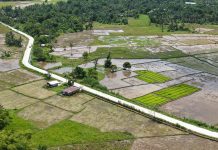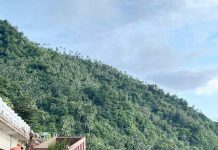TABON-TABON, Leyte – Marivic Luban, 38, was busy assisting a mason putting red cement in the flooring of her soon-to-be home at Sitio Gubat, Mering village, this town. She happily welcomed her visitors, who paid her a surprise visit in a blazing hot summer. She excitedly shook the hands of guests who made it possible for her family to have a new house, six months after supertyphoon Yolanda decimated Eastern Visayas. “Damo na salamat ma’am, salamat sirs (Thank you very much ma’am, sirs),” were the only words that came from Luban’s mouth as she stood before her unexpected guests. Her guests happened to be Philippine Red Cross (PRC) Secretary General Gwendolyn Pang; International Federation of Red Cross head of delegation Leyte Operations Steve MacAndrew; PRC head of Task Force Yolanda Leyte Valdmor Aguilar; PRC shelter coordinator Allan Mosqueda and PRC staff and volunteers and International Federation of Red Cross and Red Crescent Movement head of delegation in the Philippines, Marcel Fortier who was impressed when told that the houses were constructed in just 10 days. “I am really grateful with the Philippine Red Cross. Without their help, we could not have this kind of house. This is really a big help to us,” Luban, a mother of six children, said. According to her, their house was totally damaged, save for their kitchen where her family hid on the onslaught of Yolanda. Prior to the repair of their house, tarpaulins distributed by the PRC saved their family from the elements, she said. They formally transferred to their new home last May 13. “This shelter program is a joint project of the societies of IFRC, PRC and the International Committee on Red Cross (ICRC). We plan to build more durable homes that can withstand 220kph winds, spacious and decent place for the survivors of the typhoon,” said Pang on the assistance the groups have for extended to the survivors of Yolanda in all the 47 affected municipalities in the country. “We are now geared in supporting the long-term recovery of survivors in terms of housing, livelihood, health, water networks and education,” she added. The shelter has a floor area of 24-square meters with a provision for toilet and kitchen. It is made of cement and plywood with GI sheets and roofing is pitched at 30-degrees to withstand strong winds. Roof will be painted with red color and the wall will be in white. “It will be the sweat equity of the beneficiaries in painting the house. We will provide the paint materials but they will be the one to paint their new shelter,” said Engr. Albert Bulagsac, senior project engineer of the shelter program of the organization. Aguilar said each unit cost P100, 000 as he said that the movement would construct 52 units in Barangay Mering. “We will duplicate this in all the 20 municipalities in Leyte. We target 1,000 permanent houses in each municipality while 5,000 houses for the resettlement in Tacloban City,” he added. The beneficiaries were selected by the Barangay Recovery Committee that the PRC had established in the barangays. It worked closely with the Department of Social Welfare and Development (DSWD) in choosing the beneficiaries to ensure that it really addresses the most vulnerable. About 16 million people were affected by Yolanda with thousands losing family members, homes and incomes. To date, one million people were reached through Red Cross emergency relief distributions including cooked meals, dry food rations, none-food household items, hygiene kits and emergency shelter materials. There were 138,435 total households that received emergency shelter support across affected region. The Red Cross and Red Crescent Movement have covered 25 percent of the total emergency shelter needs across the affected region. PRC chairman Richard Gordon said that 50,000 households benefitted from the unconditional cash grant of up to P5, 000. The focus is now on the recovery phase which is expected to cost 320 million Swiss Francs over the next three years. Housing has always been a priority on the onset of the rainy season, leaving tens of thousands living in bunkhouses, tents and shanties as most vulnerable. The amount has empowered the beneficiaries to buy what the pressing needs in the family and it also helps revive the economy. “It is still a long road to recovery, but the resilience of the Taclobanons and the people from Eastern Visayas is really amazing. We are not only helping them meet their needs, but also help them in preparing for any disasters that will come their way,” said Pang. (VICKY C. ARNAIZ)



